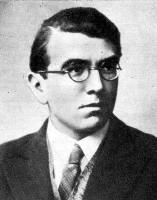Henryk Zygalski
(1906-1978)

Henryk Zygalski was a Polish mathematician and cryptologist. A student of the Mathematical Institute at the University in Poznan, he was given in 1929, along with twenty-odd of his fellow-students, a rudimentary training in codebreaking during a special course, organized by the military. The real aim of the course was to find cryptological talents. Three of the students, Zygalski Marian Rejewski, and Jerzy Różycki, were chosen. The most promising among them, Rejewski, was sent after his graduation for a one-year period of advanced study in actuarial mathematics to Goettingen.
In the autumn of 1930, a new branch of the Ciphers Office (Biuro Szyfrow) opened in utmost secrecy in Poznan and Zygalski and Różycki began to work there. It was located in a vault in the Army's regional command post in the outskirts of Poznan - a building built by Kaiser Wilhelm II as the official residence for the Crown Prince. They were later joined there by Rejewski.
In 1932, the group was moved to Warsaw where they began work as regular employees at the Cipher Bureau. It was there that they were given the task of breaking the code of the Enigma machine. Rejewski developed a scheme of decryption from a mathematical viewpoint. They were able to build replicas of the Enigma. With the help of these they began to decifer German military communications.
To facilitate decryption Rajewski designed an electromechanical programmable machine which he called 'Bomba' (Polish for bomb) because of its cylindrical shape and the bomb-like ticking noise it made. Zygalski, on the other hand developed a completely new method using perforated paper sheets
In 1934, the General Staff's Cipher Office established a new site for their German branch (BS-4) in the Kabaty Forest near Warsaw. It was at that location that on July 25, 1939, the Poles gave the French and the British replicas of Polish made Enigmas together with the drawings and information on the Enigma, Bomba and the decryption information. Later, when Germany invaded Poland in September, the group was ordered to evacuate to Rumania. Eluding the Rumanian authorities, they managed to contact the French who arranged for them to come to France. A cryptographic unit was organized in France and continued to function even after the fall of France. Evacuated with Rejewski to Britain in 1943, he became a member of the successful code braking operation at Bletchley Park, the top secret British codebraking facility. After the war he remained in Britain where he died in 1978.


